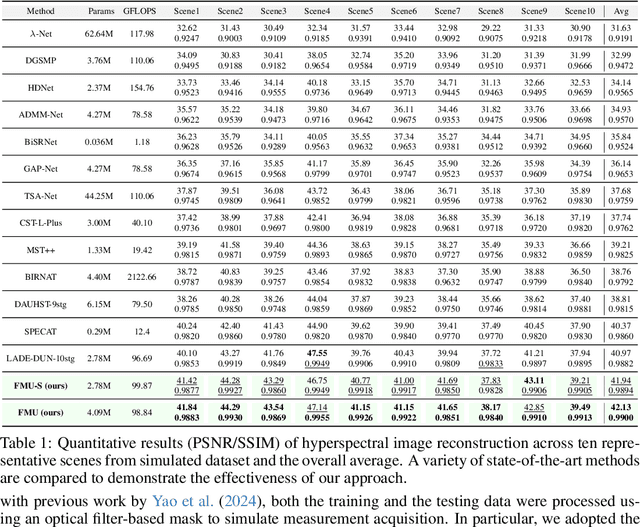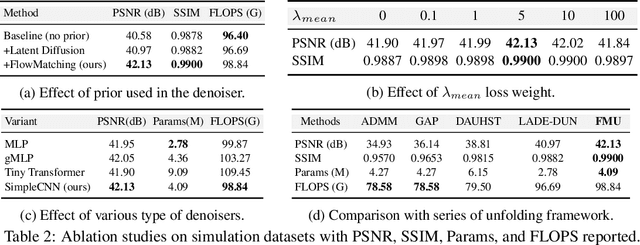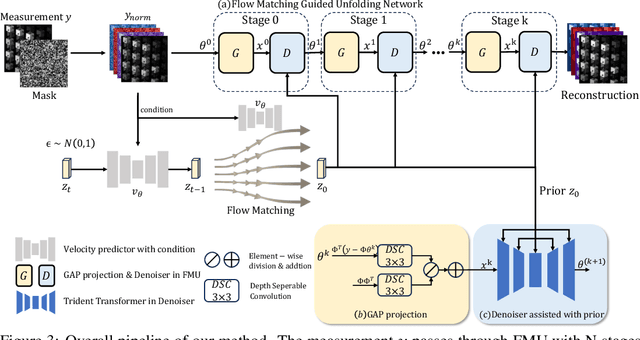Yulun Zhang
Flow-Matching Guided Deep Unfolding for Hyperspectral Image Reconstruction
Oct 02, 2025



Abstract:Hyperspectral imaging (HSI) provides rich spatial-spectral information but remains costly to acquire due to hardware limitations and the difficulty of reconstructing three-dimensional data from compressed measurements. Although compressive sensing systems such as CASSI improve efficiency, accurate reconstruction is still challenged by severe degradation and loss of fine spectral details. We propose the Flow-Matching-guided Unfolding network (FMU), which, to our knowledge, is the first to integrate flow matching into HSI reconstruction by embedding its generative prior within a deep unfolding framework. To further strengthen the learned dynamics, we introduce a mean velocity loss that enforces global consistency of the flow, leading to a more robust and accurate reconstruction. This hybrid design leverages the interpretability of optimization-based methods and the generative capacity of flow matching. Extensive experiments on both simulated and real datasets show that FMU significantly outperforms existing approaches in reconstruction quality. Code and models will be available at https://github.com/YiAi03/FMU.
FideDiff: Efficient Diffusion Model for High-Fidelity Image Motion Deblurring
Oct 02, 2025Abstract:Recent advancements in image motion deblurring, driven by CNNs and transformers, have made significant progress. Large-scale pre-trained diffusion models, which are rich in true-world modeling, have shown great promise for high-quality image restoration tasks such as deblurring, demonstrating stronger generative capabilities than CNN and transformer-based methods. However, challenges such as unbearable inference time and compromised fidelity still limit the full potential of the diffusion models. To address this, we introduce FideDiff, a novel single-step diffusion model designed for high-fidelity deblurring. We reformulate motion deblurring as a diffusion-like process where each timestep represents a progressively blurred image, and we train a consistency model that aligns all timesteps to the same clean image. By reconstructing training data with matched blur trajectories, the model learns temporal consistency, enabling accurate one-step deblurring. We further enhance model performance by integrating Kernel ControlNet for blur kernel estimation and introducing adaptive timestep prediction. Our model achieves superior performance on full-reference metrics, surpassing previous diffusion-based methods and matching the performance of other state-of-the-art models. FideDiff offers a new direction for applying pre-trained diffusion models to high-fidelity image restoration tasks, establishing a robust baseline for further advancing diffusion models in real-world industrial applications. Our dataset and code will be available at https://github.com/xyLiu339/FideDiff.
FlashEdit: Decoupling Speed, Structure, and Semantics for Precise Image Editing
Sep 26, 2025Abstract:Text-guided image editing with diffusion models has achieved remarkable quality but suffers from prohibitive latency, hindering real-world applications. We introduce FlashEdit, a novel framework designed to enable high-fidelity, real-time image editing. Its efficiency stems from three key innovations: (1) a One-Step Inversion-and-Editing (OSIE) pipeline that bypasses costly iterative processes; (2) a Background Shield (BG-Shield) technique that guarantees background preservation by selectively modifying features only within the edit region; and (3) a Sparsified Spatial Cross-Attention (SSCA) mechanism that ensures precise, localized edits by suppressing semantic leakage to the background. Extensive experiments demonstrate that FlashEdit maintains superior background consistency and structural integrity, while performing edits in under 0.2 seconds, which is an over 150$\times$ speedup compared to prior multi-step methods. Our code will be made publicly available at https://github.com/JunyiWuCode/FlashEdit.
SODiff: Semantic-Oriented Diffusion Model for JPEG Compression Artifacts Removal
Aug 10, 2025Abstract:JPEG, as a widely used image compression standard, often introduces severe visual artifacts when achieving high compression ratios. Although existing deep learning-based restoration methods have made considerable progress, they often struggle to recover complex texture details, resulting in over-smoothed outputs. To overcome these limitations, we propose SODiff, a novel and efficient semantic-oriented one-step diffusion model for JPEG artifacts removal. Our core idea is that effective restoration hinges on providing semantic-oriented guidance to the pre-trained diffusion model, thereby fully leveraging its powerful generative prior. To this end, SODiff incorporates a semantic-aligned image prompt extractor (SAIPE). SAIPE extracts rich features from low-quality (LQ) images and projects them into an embedding space semantically aligned with that of the text encoder. Simultaneously, it preserves crucial information for faithful reconstruction. Furthermore, we propose a quality factor-aware time predictor that implicitly learns the compression quality factor (QF) of the LQ image and adaptively selects the optimal denoising start timestep for the diffusion process. Extensive experimental results show that our SODiff outperforms recent leading methods in both visual quality and quantitative metrics. Code is available at: https://github.com/frakenation/SODiff
Steering One-Step Diffusion Model with Fidelity-Rich Decoder for Fast Image Compression
Aug 07, 2025Abstract:Diffusion-based image compression has demonstrated impressive perceptual performance. However, it suffers from two critical drawbacks: (1) excessive decoding latency due to multi-step sampling, and (2) poor fidelity resulting from over-reliance on generative priors. To address these issues, we propose SODEC, a novel single-step diffusion image compression model. We argue that in image compression, a sufficiently informative latent renders multi-step refinement unnecessary. Based on this insight, we leverage a pre-trained VAE-based model to produce latents with rich information, and replace the iterative denoising process with a single-step decoding. Meanwhile, to improve fidelity, we introduce the fidelity guidance module, encouraging output that is faithful to the original image. Furthermore, we design the rate annealing training strategy to enable effective training under extremely low bitrates. Extensive experiments show that SODEC significantly outperforms existing methods, achieving superior rate-distortion-perception performance. Moreover, compared to previous diffusion-based compression models, SODEC improves decoding speed by more than 20$\times$. Code is released at: https://github.com/zhengchen1999/SODEC.
QuantVSR: Low-Bit Post-Training Quantization for Real-World Video Super-Resolution
Aug 06, 2025



Abstract:Diffusion models have shown superior performance in real-world video super-resolution (VSR). However, the slow processing speeds and heavy resource consumption of diffusion models hinder their practical application and deployment. Quantization offers a potential solution for compressing the VSR model. Nevertheless, quantizing VSR models is challenging due to their temporal characteristics and high fidelity requirements. To address these issues, we propose QuantVSR, a low-bit quantization model for real-world VSR. We propose a spatio-temporal complexity aware (STCA) mechanism, where we first utilize the calibration dataset to measure both spatial and temporal complexities for each layer. Based on these statistics, we allocate layer-specific ranks to the low-rank full-precision (FP) auxiliary branch. Subsequently, we jointly refine the FP and low-bit branches to achieve simultaneous optimization. In addition, we propose a learnable bias alignment (LBA) module to reduce the biased quantization errors. Extensive experiments on synthetic and real-world datasets demonstrate that our method obtains comparable performance with the FP model and significantly outperforms recent leading low-bit quantization methods. Code is available at: https://github.com/bowenchai/QuantVSR.
Audio-Assisted Face Video Restoration with Temporal and Identity Complementary Learning
Aug 06, 2025Abstract:Face videos accompanied by audio have become integral to our daily lives, while they often suffer from complex degradations. Most face video restoration methods neglect the intrinsic correlations between the visual and audio features, especially in mouth regions. A few audio-aided face video restoration methods have been proposed, but they only focus on compression artifact removal. In this paper, we propose a General Audio-assisted face Video restoration Network (GAVN) to address various types of streaming video distortions via identity and temporal complementary learning. Specifically, GAVN first captures inter-frame temporal features in the low-resolution space to restore frames coarsely and save computational cost. Then, GAVN extracts intra-frame identity features in the high-resolution space with the assistance of audio signals and face landmarks to restore more facial details. Finally, the reconstruction module integrates temporal features and identity features to generate high-quality face videos. Experimental results demonstrate that GAVN outperforms the existing state-of-the-art methods on face video compression artifact removal, deblurring, and super-resolution. Codes will be released upon publication.
DPoser-X: Diffusion Model as Robust 3D Whole-body Human Pose Prior
Aug 01, 2025Abstract:We present DPoser-X, a diffusion-based prior model for 3D whole-body human poses. Building a versatile and robust full-body human pose prior remains challenging due to the inherent complexity of articulated human poses and the scarcity of high-quality whole-body pose datasets. To address these limitations, we introduce a Diffusion model as body Pose prior (DPoser) and extend it to DPoser-X for expressive whole-body human pose modeling. Our approach unifies various pose-centric tasks as inverse problems, solving them through variational diffusion sampling. To enhance performance on downstream applications, we introduce a novel truncated timestep scheduling method specifically designed for pose data characteristics. We also propose a masked training mechanism that effectively combines whole-body and part-specific datasets, enabling our model to capture interdependencies between body parts while avoiding overfitting to specific actions. Extensive experiments demonstrate DPoser-X's robustness and versatility across multiple benchmarks for body, hand, face, and full-body pose modeling. Our model consistently outperforms state-of-the-art alternatives, establishing a new benchmark for whole-body human pose prior modeling.
Segment Concealed Objects with Incomplete Supervision
Jun 10, 2025Abstract:Incompletely-Supervised Concealed Object Segmentation (ISCOS) involves segmenting objects that seamlessly blend into their surrounding environments, utilizing incompletely annotated data, such as weak and semi-annotations, for model training. This task remains highly challenging due to (1) the limited supervision provided by the incompletely annotated training data, and (2) the difficulty of distinguishing concealed objects from the background, which arises from the intrinsic similarities in concealed scenarios. In this paper, we introduce the first unified method for ISCOS to address these challenges. To tackle the issue of incomplete supervision, we propose a unified mean-teacher framework, SEE, that leverages the vision foundation model, ``\emph{Segment Anything Model (SAM)}'', to generate pseudo-labels using coarse masks produced by the teacher model as prompts. To mitigate the effect of low-quality segmentation masks, we introduce a series of strategies for pseudo-label generation, storage, and supervision. These strategies aim to produce informative pseudo-labels, store the best pseudo-labels generated, and select the most reliable components to guide the student model, thereby ensuring robust network training. Additionally, to tackle the issue of intrinsic similarity, we design a hybrid-granularity feature grouping module that groups features at different granularities and aggregates these results. By clustering similar features, this module promotes segmentation coherence, facilitating more complete segmentation for both single-object and multiple-object images. We validate the effectiveness of our approach across multiple ISCOS tasks, and experimental results demonstrate that our method achieves state-of-the-art performance. Furthermore, SEE can serve as a plug-and-play solution, enhancing the performance of existing models.
* IEEE TPAMI
ReCalKV: Low-Rank KV Cache Compression via Head Reordering and Offline Calibration
May 30, 2025Abstract:Large language models (LLMs) have achieved remarkable performance, yet their capability on long-context reasoning is often constrained by the excessive memory required to store the Key-Value (KV) cache. This makes KV cache compression an essential step toward enabling efficient long-context reasoning. Recent methods have explored reducing the hidden dimensions of the KV cache, but many introduce additional computation through projection layers or suffer from significant performance degradation under high compression ratios. To address these challenges, we propose ReCalKV, a post-training KV cache compression method that reduces the hidden dimensions of the KV cache. We develop distinct compression strategies for Keys and Values based on their different roles and varying importance in the attention mechanism. For Keys, we propose Head-wise Similarity-aware Reordering (HSR), which clusters similar heads and applies grouped SVD to the key projection matrix, reducing additional computation while preserving accuracy. For Values, we propose Offline Calibration and Matrix Fusion (OCMF) to preserve accuracy without extra computational overhead. Experiments show that ReCalKV outperforms existing low-rank compression methods, achieving high compression ratios with minimal performance loss. Code is available at: https://github.com/XIANGLONGYAN/ReCalKV.
 Add to Chrome
Add to Chrome Add to Firefox
Add to Firefox Add to Edge
Add to Edge